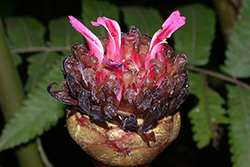e-Flora of Thailand
Volume 16 > Part 2 > Year 2023 > Page 492 > Zingiberaceae > Etlingera
9. Etlingera maingayi (Baker) R.M.Sm.wfo-0000415660
Notes Roy. Bot. Gard. Edinburgh 43(2): 247. 1986; Khaw, Gard. Bull. Singapore 53: 208. 2001.— Amomum maingayi Baker, Fl. Brit. India 6: 235. 1892.— Hornstedtia maingayi (Baker) Ridl., J. Straits Branch Roy. Asiat. Soc. 32: 150. 1899.— Phaeomeria maingayi (Baker) K.Schum., Pflanzenr. IV, 46 (Heft 20): 266. 1904; Ridl., Fl. Malay Penins. 4: 272. 1924; Holttum, Gard. Bull. Singapore 13: 180. 1950.— Nicolaia maingayi (Baker) K.Larsen, Nat. Hist. Bull. Siam Soc. 23: 574. 1970.
Accepted Name : This is currently accepted.
Description : Rhizome short-creeping, 1.2–1.7 cm diam., ± pubescent, scales to 4 cm long; stilt roots sometimes present to 30 cm long. Leafy shoots to 3 m long, forming loose clumps, to 25 cm between neighbouring leafy shoots; base to 4.5 cm diam., pale brownish to pink, sericeous; sheath greenish, glabrous, margin ± ciliate; ligule to (8–)12–16 mm long, entire, rounded, slightly asymmetrical, green, glabrous, margin densely ciliate; petiole 0–1 cm long, glabrous; blade narrowly elliptic to obovate, to 64 by 15 cm, length to width ratio 4.1–4.3, smooth, plain green, young leaves sometimes tinged ± brownish pink, glabrous or pubescent beneath, base cuneate, ± oblique, apex shortly acuminate, margin ± ciliate. Flowering shoot 33–90 cm long, erect, aerial, receptacle ovoid, to 2 cm long, with ca 80 flowers, to 12 open at a time; peduncle shortly horizontal, then erect, aerial, 28–85 cm long, glabrous, pubescent near base of bracts; peduncular bracts to 5 by 2.5 cm, to 12 cm apart, exposing axis, upper ones shorter and wider (ca 3.5 by 5 cm) enclosing base of spike, narrowly to broadly ovate, pale greenish brown, pubescent, apex emarginate, mucronate; spike raised well above ground, 5 cm long (including flowers), flowers extending 2 cm above bracts; spike only including bracts obovoid, apex ± flattened, 3 by 3.5–4 cm; sterile bracts: ca 4, spiralling, lower to ca 3.5 by 5 cm, broadly ovate, apex emarginate, mucronate, exposed edges pink to red, densely white-sericeous; fertile bracts 2.3–2.6 by 0.8–3.5 cm, broadly ovate to narrowly obovate to spathulate, apex emarginate to round, lower bracts mucronate, red, sericeous; pedicel absent; bracteoles 1.9–2.2 cm long, densely sericeous, apex bidentate, bluntly pointed, ciliate, each with a subapical mucro to 2 mm long, pointing laterally in opposite directions. Flower ca 4.1 cm long; ovary ca 3 by 3 mm, glabrous, shiny; style 3.4 cm long, slightly hairy near apex; stigma 2.5 mm wide, red, reniform with an adaxial knob, ostiole semilunar, transverse 2.3 mm, facing ± forwards; epigynous gland 4 mm long, split adaxially and half way abaxially, parallel-sided, apex pointed, glabrous; calyx 3.3–3.4 cm long, reaching apex of anther and 3 mm longer than dorsal corolla lobe, red, ± pubescent, apex tridentate, pubescent, with subapical mucro 1–1.5 mm long extending beyond apex; floral tube 2.6 cm long, glabrous, tube inside glabrous below point of lobe insertion; lobes red, sparsely sericeous, dorsal lobe oblong ca 1.4 by 0.35 cm, reaching middle of anther, lateral lobes oblong ca 1.4 by 0.22 cm; staminal tube ca 1.1 cm long, glabrous outside, pubescent inside; labellum trilobed, angled ca 165° to the tube, ca 1.8 by 1 cm, pink, pubescent adaxially near base, lateral lobes erect closely on either side of stamen, margin entire, white, central lobe bilobed with 1.5 mm incision, extending ca 1 cm beyond anther, membranous, repand, ± crisped; stamen sessile; anther ca 8 by 3 mm, parallel-sided, glabrous, angled 150°, red, margin at apex slightly emarginate; thecae dehiscent 5 mm in centre, slightly pubescent. Infructescence erect, peduncle to 90 cm, head ca 5 by 4–6 cm, subglobular, bracts persistent, with up to ca 15 fruits per head; pedicel to 4 mm long. Fruit 2–2.5 by 2–3.5 cm, obovoid to oblate, widest towards apex, irregularly rounded, apex depressed, only base of calyx persistent, shiny scarlet red, glabrous; seeds ca 2.5 by 2.5–4 mm, widest at apex, flat-topped.
Thailand : SOUTH-WESTERN: Kanchanaburi, Prachuap Khiri Khan; PENINSULAR: Ranong, Surat Thani, Phangnga, Nakhon Si Thammarat, Trang, Satun, Pattani, Yala, Narathiwat.
Distribution : Indonesia (Sumatra), Malaysia (Peninsular – type).
Ecology : Lowland forests, 50–1,000 m alt.
Vernacular : Put (ปุด), kala khi maeo (กะลาขี้แมว), kala (กาลา), katang api (Malay language).
Uses: Flowers edible.
Notes: With its long (to 85 cm) and erect peduncle and relatively small (to 5 by 4 cm), subglobose inflorescence with densely sericeous bracts, and its infructescence of shiny ruby-red fruits, Etlingera maingayi cannot be mistaken for any other species in Thailand. Two varieties have been recognised in Peninsular Malaysia but this has no implications for Thailand.


